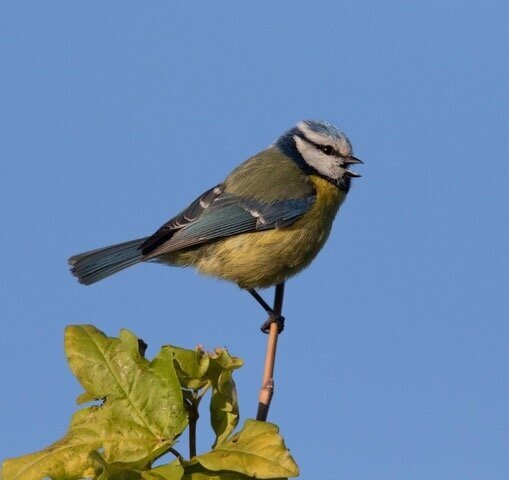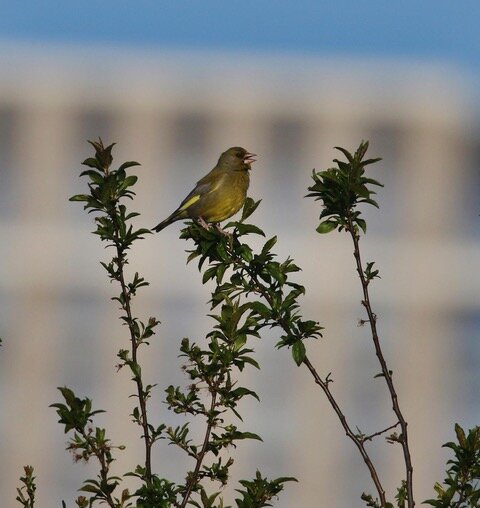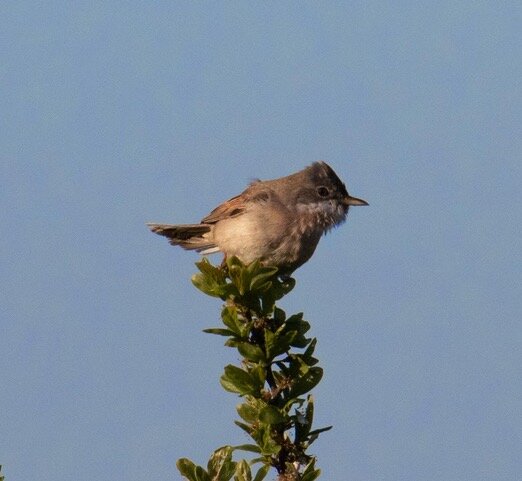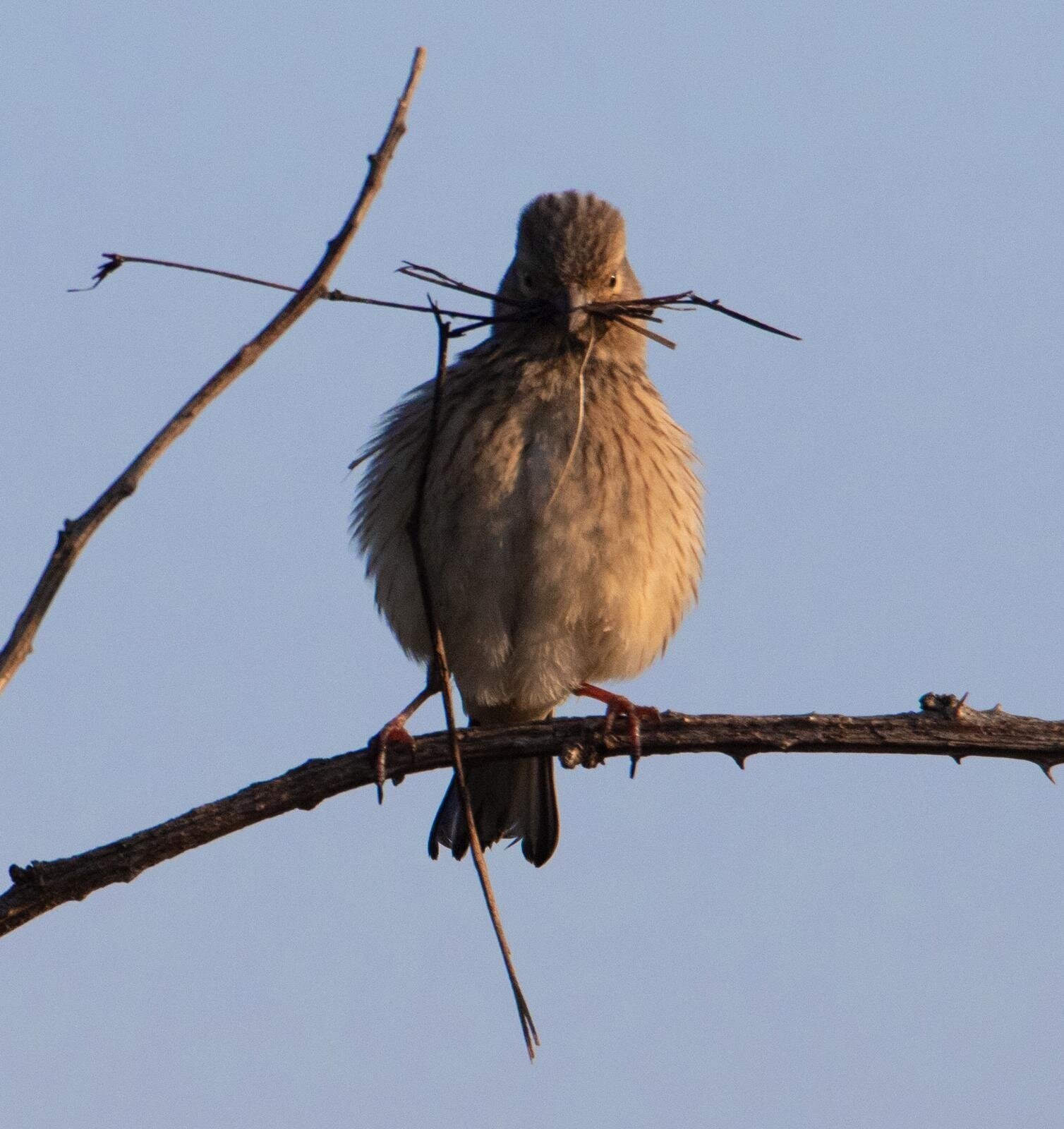April birds: warblers, wheatears and the first swallow of 2021
Common Redstart by Paul Thomas




Barbara Crowther writes:
We were expecting the arrival of many more warblers in April, and we’ve not been disappointed. Most visibly, common whitethroats are now visible in most areas of bramble along the HS2 fencing and in the eastern meadow and copse along the playing fields. Their scratchy, fluttering song flights are joyful to behold: of the many warblers we have in Britain, it’s only common and sedge warblers that tend to put on these types of displays, often coming to land on the top of a shrub or bramble patch where their characteristic white throats can clearly be seen as they continue to sing.
Left: Lesser Whitethroat by Barbara Crowther
Our first whitethroat was spotted briefly in the eastern meadow on 14 April, and within a few days were being seen in numbers every day. It was not until 27 April that we caught sight and sound of our first lesser whitethroat, which has a much less scratchy, more trilling sound (not dissimilar to a greenfinch), and has a much more dapper, streamlined grey and white appearance. But there is definitely at least one and probably two singing males in the copse at the top of the HS2 fencing alongside the model aircraft zone.
Numbers of chiffchaffs and blackcaps increased as the month went on, you can see and hear them daily along the embankment, in all the perimeter woodlands and the central copse as well as Martin Bell’s Wood and the copses along Scrubs lane. Francis also picked up the sound of a willow warbler in the central copse on 17 April, but no-one has yet been able to snap one in 2021 for the record.
April’s biggest moment of excitement was a male common redstart - spotted on a low branch of a shrub close to the path that cuts north-south across the meadow area on 15 April, although we now believe it was there the day before. This beautiful bird, with russety orange breast, black head with white-grey crown and slatey blue-grey back was still hanging around the same area the following day too, and posed beautifully for Paul to take the picture here [top], but was gone again by 17 April. And although not at the Scrubs itself, there was a lot of excitement caused by Oli’s sighting of a black redstart nearby on the tall buildings at Westfield centre.
Another thrill was a male wheatear which appeared as the end of morning reward for some early birders who had arrived at 5am for the dawn chorus on 25 April. It was first spotted perching on the bench on the main path down the grassland, before flitting into the brambles and then over the fencing into the HS2 compound, where it hopped on the ground for several minutes before an HS2 worker flushed it off into the embankment.
For the third month in a row, a snipe (probably common) was flushed in the Scrubs - this time it was Lucas who found it in the long grass just by the goal posts where the path goes to the Stop HS2 protection camp.
Our first swallow, traditionally the heralds of the start of summer, was reported on 14 April, flying over the HS2 enclosure near Chat’s Paddock. Whilst they look black and white in the air, with their characteristic long forked tails, they have remarkable deep blue iridescent plumage in the right light, and if you’re lucky you can also see its deep red throat. We should see many more hirundines - swallows, swifts and martins - as spring turns to summer and more insects fill the air.
We haven’t seen so quite many meadow pipits in April, hopefully because they are busy nesting now, but they are certainly still around. Paul enjoyed a ‘mipit’ song flight on 9 April, then both Magnus and David Jeffreys saw some on 16 April. A pair flew over the eastern meadow on 21 April, and another was also cheekily sat on the HS2 fencing before jumping down into the long grass on 26 April.
We’re very lucky to have linnets nesting at Wormwood Scrubs - these characterful finches are on the conservation red list nationally, but we see them every day now, especially in the bramble areas. Look out for the reddish forehead and breast of the male, the female is much browner. We’ve seen quite a few moving back and forth with nesting materials. Like the meadow pipits, they will no doubt also be benefitting greatly from the quieter footfall in the meadow now. There are also plenty of greenfinches around, and it’s hard to miss their monotone wheezes and trills, or the yellow-green flash as they fly between woods, meadow and embankment.
We regularly see sparrowhawks - most often we see them flying along the embankment and in the northern side woods. On Friday 2 April, Bill watched a sparrowhawk displaying over Little Wormwood Scrubs. Back at the ‘Big’ Scrubs, one flew over the northern woods on 14 April, Paul spotted a female flying along the embankment on 16 April, and later the same day Magnus spotted four sparrowhawks flying west. Sophie spied one in the northern woods on 21 April, and another (possibly the same as Paul's) female was seen flying along the embankment on 23 April. Kestrels are the other raptors we see a lot - one perched on the signboard on the path across the grassland on 8 April, occasionally hopping down to the grass. Further sightings of one perched up on the embankment on 14 April, enjoying circling in morning thermals on 15 April and another on 17 April. We also spotted one flying east with a small rodent in its talons along the embankment on 25 April. Not quite at the Scrubs itself, Oliver also spotted a pale common buzzard flying towards the Scrubs from Wood Lane on 4 April.
Great spotted woodpeckers were seen, both male and females, on 15, 26 and 28 April and a green woodpecker’s unmistakeable cackling ‘yaffle' was heard emanating from Martin Bell’s Wood/riding centre area on 12 April.
It’s always worth looking up when at the Scrubs, and we did see plenty of birds by doing so in April - early mornings are good as birds move from roosting sites to watering places. As well as lesser black backed, black headed and herring gulls, those reported included a cormorant on 16 April, a grey heron on 15 April, Canada geese on 9, 15 and 25 April, Egyptian geese on 25 April, Greylag geese on 6 and 30 April.
Thousands of ring-necked parakeets roost at Wormwood Scrubs, mostly around the Braybrook St woods and central copse, but we’ve seen a lot in Scrubs Lane woods during April. They seem to love the wych elm buds, and the carpets of blossom on the paths are often the remnants of their rampages through these trees.
Following the destruction of the area now behind HS2 fencing, it’s been nice to see how resilient, adaptable and ‘borderless' the birds are. Many dunnocks, song thrushes, linnets and whitethroats that would have been deep in the brambles along the embankment have migrated into the remaining bramble patches alongside the fencing, and the area alongside the playing fields. The HS2 compound is off limits to us, but many birds have been happily foraging there in the last month - one morning I watched three greenfinches, two blackbirds, a couple of house sparrows, three song thrushes, four linnets, a pair of dunnocks, a robin and a meadow pipit all in the space of 5 minutes near the lonely bench I used to sit on!
What to look for in May
Birds will be nesting in earnest during May, so look out for them carrying nesting material or food items. The robins always get an early start to the season, and we’re already seeing and hearing their young fledglings, often low in scrub, calling for food with a high pitched ’tweep’ sound. Baby robins are surprisingly large, with very freckled plumage that acts as great camouflage. Great tits, blue tits and long tailed tits will all be nesting now too, and may have several broods in one season.
Look out for more warblers in May - chiffchaffs, blackcaps and common whitethroats should be plentiful, and we’ll be looking for willow warblers and lesser whitethroats. There are plenty of other warbler sub-species that may make appearances: garden, wood, sedge, reed, grasshopper and Cetti’s warblers have all been reported in previous years, so we’ll be listening out for their various calls. Some of them can be fiendishly difficult to see clearly, so learning their songs as well as the differences of plumage and behaviour is the key to ID for British warblers. The BTO has a useful little set of warbler ID videos for the enthusiasts!l
As weather gets warmer, we hope to see swifts over the Scrubs, and the hirundines - swallows plus house and sand martins - should all become more likely sightings as spring turns to summer.
We didn’t get any wagtails reported at the Scrubs in April, but Paul thinks May might be lucky for a yellow wagtail - who knows if he will turn out to be Nostradamus again? We've also had spotted flycatchers at the Scrubs in previous years in this month, and that would be a treat. .
As well as the usual kestrel and sparrowhawks, other birds of prey passing over are always possible: buzzards, red kite and, if we’re lucky, even hobbies or peregrine falcons.
Happy birding everyone! Let us know what you see :)
April bird sightings contributors: Barbara Crowther, Paul Thomas, Magnus Andersson, Sophie Cogan, David Jeffreys, Laura Williamson, Lucas von Chamier, Anne Middleton-Smith, Bill Haines, Francis O'Sullivan.
If you’d like to join the ScrubHub, the WhatsApp group dedicated to sharing bird sightings at Wormwood Scrubs, the link to join is https://chat.whatsapp.com/LwFtlsE8fJaLPlV4KF0S2X

